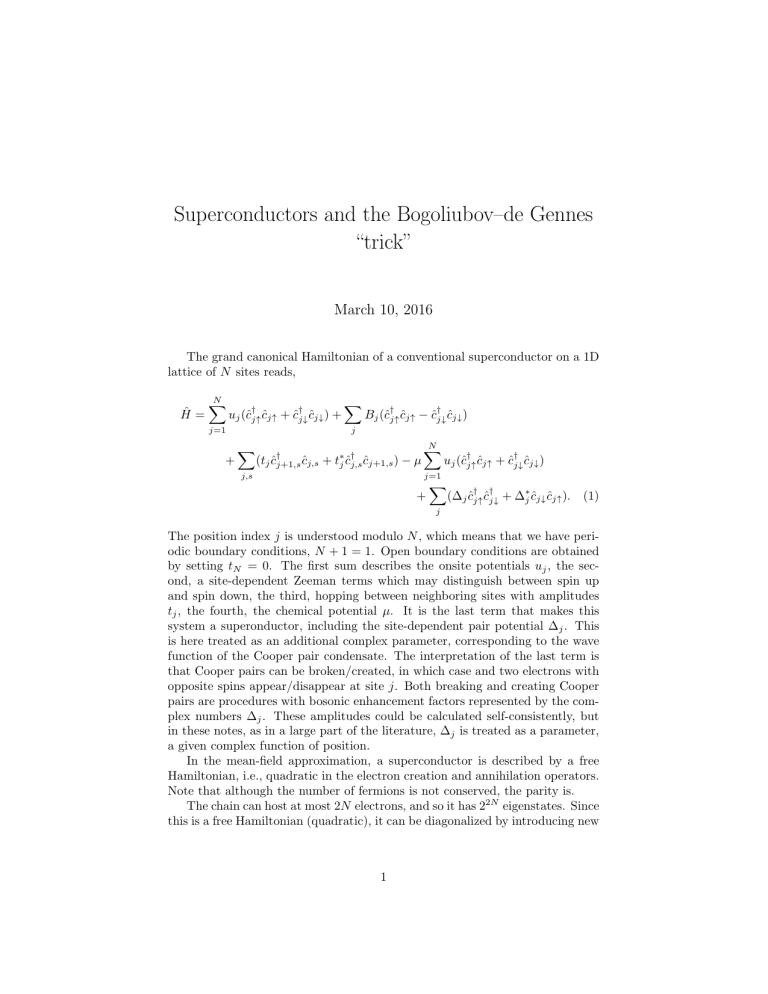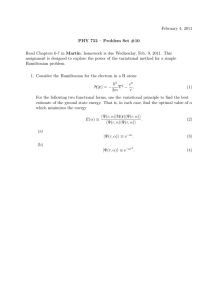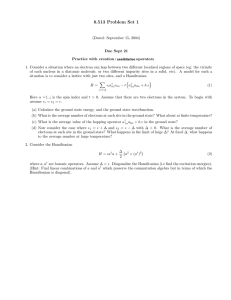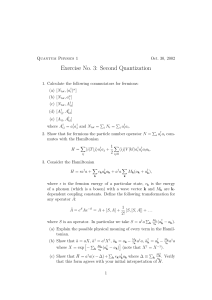
Superconductors and the Bogoliubov–de Gennes
“trick”
March 10, 2016
The grand canonical Hamiltonian of a conventional superconductor on a 1D
lattice of N sites reads,
Ĥ =
N
X
uj (ĉ†j↑ ĉj↑ + ĉ†j↓ ĉj↓ ) +
j=1
+
X
Bj (ĉ†j↑ ĉj↑ − ĉ†j↓ ĉj↓ )
j
N
X
X
uj (ĉ†j↑ ĉj↑ + ĉ†j↓ ĉj↓ )
(tj ĉ†j+1,s ĉj,s + t∗j ĉ†j,s ĉj+1,s ) − µ
j=1
j,s
+
X
(∆j ĉ†j↑ ĉ†j↓ + ∆∗j ĉj↓ ĉj↑ ). (1)
j
The position index j is understood modulo N , which means that we have periodic boundary conditions, N + 1 = 1. Open boundary conditions are obtained
by setting tN = 0. The first sum describes the onsite potentials uj , the second, a site-dependent Zeeman terms which may distinguish between spin up
and spin down, the third, hopping between neighboring sites with amplitudes
tj , the fourth, the chemical potential µ. It is the last term that makes this
system a superonductor, including the site-dependent pair potential ∆j . This
is here treated as an additional complex parameter, corresponding to the wave
function of the Cooper pair condensate. The interpretation of the last term is
that Cooper pairs can be broken/created, in which case and two electrons with
opposite spins appear/disappear at site j. Both breaking and creating Cooper
pairs are procedures with bosonic enhancement factors represented by the complex numbers ∆j . These amplitudes could be calculated self-consistently, but
in these notes, as in a large part of the literature, ∆j is treated as a parameter,
a given complex function of position.
In the mean-field approximation, a superconductor is described by a free
Hamiltonian, i.e., quadratic in the electron creation and annihilation operators.
Note that although the number of fermions is not conserved, the parity is.
The chain can host at most 2N electrons, and so it has 22N eigenstates. Since
this is a free Hamiltonian (quadratic), it can be diagonalized by introducing new
1
fermionic operators,
dˆl =
X
ul,j,s ĉj,s + vl,j,s ĉ†j,s ;
(2)
∗
u∗l,j,s ĉ†j,s + vl,j,s
ĉj,s .
(3)
j,s
dˆ†l =
X
j,s
We require that the dˆl obey fermionic commutation relations,
{dˆl , dˆm } = 0;
{dˆl , dˆ†m } = δlm .
(4)
What requirements do the commutation relations impose on the
coefficients ul,j,s and vl,j,s ?
These particles diagonalize the Hamiltonian in the sense that
Ĥ =
2N
X
El dˆ†l dˆl .
(5)
l=1
This looks very much like the standard procedure for free Hamiltonians, however, because of the superconducting pair potential, ∆, we cannot take dˆl to be a
linear combination of only electron annihilation operators, ĉj . This means that
dˆl and dˆ†l are described on the same footing. We can actually use this freedom
to ensure that all of the dˆ operators describe positive energy excitations:
El ≥ 0.
(6)
This can be achieved by redefining the negative energy fermions as dˆ ↔ dˆ† .
Once we have found the operators dˆl , we can easily interpret the spectrum
of Ĥ as consisting of states with a given number of fermions:
|0, . . . , 0, 0, 1i = dˆ†1 |GSi
|0, . . . , 0, 1, 0i = dˆ† |GSi
|0, . . . , 0, 1, 1i =
2
dˆ†2 dˆ†1
|GSi
(7)
(8)
(9)
In the above definition, the Ground State |GSi of the Hamiltonian was
introduced. This is a complicated state when expressed in the basis of the
original fermions ĉj : it is in general a superposition of states with different
particle numbers, since the Hamiltonian does not conserve particle number.
However, since the Hamiltonian conserves the parity of the particle number, the
ground state is a superposition of states with only odd, or only even number of
particles ( ĉl fermions).
One way to construct the ground state |GSi is to turn the logic of the
previous paragraph around. A state containing no ĉl fermions, |0i, is far from
the ground state of the Hamiltonian, and can contain a superposition different
2
number of excitations dˆ fermions. Starting from such a simple state, we can
ˆ then we are left
take away all the components of it that contain excitations d:
with |GSi, if the initial state had a |GSi component. Alternatively, if we are
out of luck, we are left with 0, in which case we have to try with a different
initial state, practically one with a different fermion parity.
dˆ2N dˆ2N −1 . . . dˆ1 |0i = |GSi or 0;
|GSi hGS| = dˆ2N dˆ2N −1 . . . dˆ1
1
X
...
n1 =0
1
1
X
(10)
!
2N
ĉ†n
2N
1
. . . ĉ†n
1
|0i h0| ĉn1 1
2N
. . . ĉn2N
dˆ†1 dˆ†2 . . . dˆ†2N
(11)
n2N =0
The Bogoliubov–de Gennes formalism
The key to understanding the dynamics of the system is finding the coefficients
ul,j,s , vl,j,s of the eigenstates dˆl , as in Eq. (2). There is a trick to obtain these,
called the Bogoliubov–de Gennes formalism, that involves a redundant representation of the states.
We begin by rewriting the Hamiltonian as
Ĥ =
2N
2N
l=1
l=1
1X
1X
El (dˆ†l dˆl − dˆl dˆ†l ) +
El .
2
2
(12)
Using a practical shorthand, this can be written as:
c† = (ĉ†1,↑ , ĉ†1,↓ , . . . , ĉ†N,↑ , ĉ†N,↓ );
(13)
c = (ĉ1,↑ , ĉ1,↓ , . . . , ĉN,↑ , ĉN,↓ );
(14)
1
1
c†α hα,β cβ + c†α ∆α,β c†β + + cβ ∆∗α,β cα ;
2
2
α,β
1 c† c
1
c
Ĥ =
H † + Trh;
c
2
2
h
∆
H=
,
−∆∗ −h̃
Ĥ =
X
(15)
(16)
(17)
where H is the matrix of the Bogoliubov-de Gennes Hamiltonian. The factors
of 1/2 were placed conveniently so as not to conflict with Eq. (1). Hermiticity of
Ĥ implies h is Hermitian. Since the electrons are fermions, ∆ can be chosen to
be a complex antisymmetric matrix. If we make this choice, the PHS symmetry,
represented by ΣX K, right away:
ΣX H? ΣX = −H.
3
(18)
Using the particle-hole symmetry of H, we can diagonalize it using only the
positive energy eigenstates,
∗
∗
uj
uj
, for j = 1, . . . , N ;
(19)
H ∗ = Ej
vj∗
vj
v
vj
H j = −Ej
, for j = 1, . . . , N,
(20)
uj
uj
where the jth eigenvector of H was written as (uj , vj )† , with uj and vj both
N -component vectors. Remember that H was a Hermitian matrix, and thus its
eigenvectors form an orthonormal basis. We can then express H as
X u∗ uj vj X vj v ∗ u∗ j
j
j
H=
Ej
−
Ej
(21)
vj∗
uj
j
j
Comparison with Eq. (12) reveals that the u’s and the v’s are truly the coefficients of the ĉ’s in the eigenmodes of the system, the dˆ fermions, as per Eq. (2).
Orthonormality of the eigenvectors translates to the required anticommutation
relations.
2
Simplest case: single site
As an illustrative case, we consider the simplest mean-field superconductor,
consisting of a single site. The Hamiltonian reads
Ĥ
=
−µ(ĉ†↑ ĉ↑ + ĉ†↓ ĉ↓ ) + B(ĉ†↑ ĉ↑ − ĉ†↓ ĉ↓ ) + ∆ĉ†↑ ĉ†↓ + ∆∗ ĉ↓ ĉ↑ . (22)
For such a small system, we can actually calculate everything in the Hilbert
space of all states:
|0i |↑↓i |↓i |↑i
0
∆∗
h0|
∆ −2µ
h↑↓|
(23)
Ĥ =
h↓|
−µ − B
−µ + B
h↑|
(24)
This 4 by 4 matrix is composed of 2 blocks of 2 by 2 matrices, both of which
have the form Xσx + Y σy + Zσz . Since such matrices will occur often later on,
we derive their spectrum here:
p
Z
X − iY
X − iY
X − iY
= ±E
; E = X 2 + Y 2 + Z 2.
X + iY
−Z
±E − Z
±E − Z
(25)
In our case,
q
E=
2
|∆| + µ2 .
4
(26)
Energy
Figure 1: Energy levels of a single-site superconductor.
5
The energy levels are shown in Fig. 1. We can interpret the energy levels
by introducing µ, B and ∆ sequentially. First, µ shifts the energy of all levels,
depending on the number of
For weak magnetic fields, B 2 < µ2 +∆2 , the ground state is |GSi = −∆∗ |0i+
(E + µ) |↑↓i. For weak ∆, this can be approximated as |GSi ≈ |0i + ∆/µ |↑↓i.
The spectrum of Ĥ is symmetric around E = −µ. This symmetry has
nothing to do with superconductivity, it is a generic feature of free Hamiltonians,
which can be explained simply. All energy levels can be obtained from the
ˆ as indicated by the
bottom up, starting with |GSi, and adding particles d,
slashed lines. Alternatively, one can go top-down: with the state where all d
fermions are present, and subtract the d’s. The symmetry point can be shifted
by onsite potentials, but is always there.
We now calculate this simplest case using the BdG formalism.
ĉ↑
−µ + B
0
0
∆
ĉ†↑ ĉ†↓ ĉ↑ ĉ↓
0
1
−µ − B
−∆
0 ĉ↓
Ĥ =
† (27)
∗
0
−∆
µ−B
0 ĉ↑
2
∆∗
0
0
µ+B
ĉ†
{z
} ↓
|
H
The BdG matrix H falls apart to two 2 × 2 matrices:
u
∆
u∗ ĉ↑ + v ∗ ĉ†↓ : B ± E;
=
v
µ±E
u
−∆
u∗ ĉ↓ + v ∗ ĉ†↑ : −B ± E;
=
.
v
µ±E
These are 4 different d operators. However, they are not independent:
h
i†
∆∗ ĉ↑ + (µ ± E)ĉ†↓ = (µ ± E) ĉ↓ + ∆ ĉ†↑ .
(28)
(29)
(30)
To compare the fermions on the rhs with the fermions from the “second batch”,
note that
−∆∗
µ±E
=
,
∆
µ∓E
(31)
which follows from E 2 = µ2 + ∆2 .
2
In the weak magnetic field case, B 2 < µ2 + |∆| , the positive energy Bogoliubov operators are:
dˆ1 = −∆∗ ĉ↓ + (µ + E)ĉ†↑ ;
dˆ2 = ∆∗ ĉ↑ + (µ +
E)ĉ†↓ .
(32)
(33)
To check consistency, you can verify that the recipe for the ground state based
on the BdG formalism gives the same |GSi as calculated above,
|GSi = dˆ1 dˆ2 |0i = dˆ1 dˆ2 |↑↓i .
6
(34)
3
Hopping
In a longer chain, it is more convenient to order the operators according to site
first, then according to creation or annihilation, then spin. This makes the PHS
less transparent, but it is easier to link with a general tight binding Hamiltonian.
1 †
ĉ
2 1,↑
4
ĉ†1,↓
ĉ†2,↑
ĉ†2,↓
ĉ1,↑
ĉ1,↓
ĉ2,↑
ĉ2,↓
ĉ1,↑
ĉ1,↓
ĉ2,↑
ĉ2,↓
†
H ĉ
1,↑
ĉ†
1,↓
†
ĉ2,↑
ĉ†2,↓
(35)
p-wave SC
(Introduction to p-wave).
Assume no s-wave ∆, only p-wave. The simplest model is a spin polarized
chain:
X
X
Ĥ =
Vj ĉ†j ĉj +
∆∗j ĉj+1 ĉj − tj ĉ†j ĉj+1 + h.c.
(36)
j
j
We use the convention of the Alicea review, without
1/2.
The BdG Hamiltonian reads
V1
0
−t1
∆1
∗
0
−V
−∆
t∗1
1
1
−t∗1 −∆1
V2
0
−t2
∆2
∗
∗
∆1
t
0
−V
−∆
t∗2
1
2
2
H=
∗
−t2 −∆2
V3
0
∆∗2
t2
0
−V3
−tN
∆N
−t∗3 −∆3
∗
∗
t3
−∆N
tN
∆∗3
the unnecessary factor of
−t∗N
∆∗N
−t3
−∆∗3
VN
0
−∆N
tN
,
∆3
t∗3
0
−VN
where we supressed the 2 × 2 zero matrices for better readability.
This can be written as
X †
X †
dˆj Uj dˆj +
dˆj Tj dˆj+1
j
(37)
(38)
j
using the notation dˆ†j = (cj †, cj ). This has the same form as a usual nearest
neighbor hopping Hamiltonian, with
Uj = Vj σz ;
Tj = −σz Re tj − iIm tj + iσy Re ∆j + iσx Im ∆j .
7
(39)
In the translation invariant bulk, we can look for eigenstates of H in the form
of dˆj = dˆ1 eikj . This choice of sign of k is so we have the same formulas as for
ordinary Hamiltonians. Bear in
Pmind though, that because of the extra complex
conjugation, we have d(k) = j (dˆ∗j,1 cj + dˆ∗j,2 c†j )e−ikj . The BdG Hamiltonian
reads,
H(k) = U + (T + T † ) cos k + i(T − T † ) sin k;
(40)
H(k) = (V − 2 Re t cos k)σz + 2 sin k(Im t − σy Re ∆ − σx Im ∆).
(41)
To see the antiunitary symmetries of this Hamiltonian, consider its complex
conjugate (remember that we conjugate in real space, meaning k flips sign too):
KH(k)K = (V − 2 Re t cos k)σz + 2 sin k(Im t + σy Re ∆ − σx Im ∆).
(42)
There is a sign flip in the term proportional to σ0 , this cannot be undone by
conjugation via a unitary operator. This means that we can only have TRS if
t ∈ R. Even then, we would need to undo the sign flip the σx term only, which
cannot be done in a unitary way. So we have TRS, represented by K, only if
both t and ∆ are real.
For PHS, all terms in H need to undergo a sign flip. We need an extra sign
flip for the σz and the σy terms, which can be achieved by a σx operator:
σx KH(k)Kσx = σx H(−k)σx = −H(k).
(43)
Thus, we have PHS, represented by σx K which squares to +1, and possibly
also TRS, represented by K, which squares to +1. So we are either in class D,
or in BDI. We look at class D first.
Express the topological invariant via the polarization.
For a 2-band Hamiltonian, this has a practical graphical representation.
H(k) = ~h(k)~σ = hx (k)σx + hy (k)σy + hz (k)σz ;
KH(k)K = H∗ (−k) = ~h(−k)~σ ∗ = hx (−k)σx − hy (−k)σy + hz (−k)σz ;
σx KH(k)Kσx = hx (−k)σx + hy (−k)σy − hz (−k)σz ;
(44)
(45)
(46)
This gives as requirement for PHS,
hx,y (k) = −hx,y (−k);
hz (k) = hz (−k).
(47)
At the TRI momenta k = 0 and k = π, this simplifies to hx,y (k = 0, π) = 0.
Since the gap has to remain open, we have 4 distinct options as to the sign of
hz (0) and hz (π). Consider the path of the unit vector of ~h(k),
~n(k) = ~h(k)/ ~h(k) ,
(48)
on the Bloch sphere. Looking at the path from the North Pole, it either comes
back there from k = 0 → π, in which case, the path looks like an 8, or goes to
the South Pole, in which case it looks like a 0. Because of PHS, the path from
8
k = 0 → −π is the mirror image of the path from k = 0 → π. In the “8” case,
this mirroring undoes any Berry phase obtained, so the polarization is 0. In the
“0” case, it ensures that the surface of the sphere is cut into 2 equal halves, thus
giving a Berry phase of π, polarization of 1/2.
We can express the topological invariant in a straightforward way in the
basis where PHS is represented by K, i.e., after transformation by σx (by Σx in
the general case).
5
Majorana basis
There is an interesting alternative basis that is often used to treat superconducting systems: Majorana fermions. For each site, two linear combinations of
ĉj and ĉ†j are introduced, denoted as âj and b̂j , so that for any j, l:
{âj , b̂l } = 0;
{âj , âl } = {b̂j , b̂l } = 2δjl .
(49)
(50)
The norm of the Majorana fermions is chosen so that for any site, â2j = b̂2j = 1.
It is simple to see that the only way to introduce these operators is:
b̂j = e−iφj /2 ĉj + eiφj /2 ĉ†j ;
âj = −i e−iφj /2 ĉj − eiφj /2 ĉ†j ;
eiφj /2
(b̂j + iâj );
2
e−iφj /2
ĉ†j =
(b̂j − iâj ).
2
ĉj =
(51)
(52)
(53)
(54)
The Hermitian (“real”) Majorana fermion operators are the “real parts” and
“imaginary parts” of the original (“complex”) fermion operators ĉ. There is a
free parameter φj , which we can set to the phase of the p-wave order parameter:
∆j = ∆j eiφj , with ∆j denoting its absolute value.
6
Exercises
Express the Hamiltonian in the Majorana basis. Show that in the simple cases
a) ∆ = t = 0 and b) µ = 0, ∆ = ±µ the Hamiltonian can be diagonalized easily.
What are the independent fermionic operators d?
9






